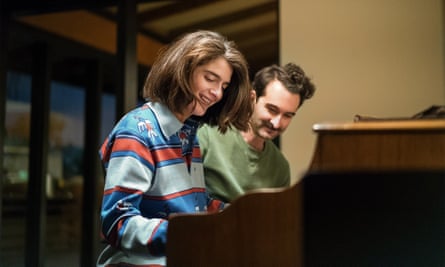Much of the conversation regarding the rise of prestige television has rightfully centered around the showrunners and writers’ rooms who’ve energized a medium that was once the province of three-camera sitcoms filmed on studio sets. But less often do we focus on the cinematographers behind the lens, many of whom never saw themselves working in television until, in the last decade or so, the schisms between the small and big screens dwindled. And not merely in the scope of the stories or the quality of scripts: never before has television looked so good, from inventive camerawork to glossy lighting.
It’s hard to ascertain exactly when the paradigm shift began, but there have certainly been seminal moments that most boldly bridged the gap between the two: the six-minute tracking shot in True Detective following Matthew McConaughey and Woody Harrelson on a drug bust comes to mind, as do early seasons of Game of Thrones and Boardwalk Empire, ambitious, world-building series that took a sledgehammer to the conventions of episodic television. That the Television Academy split its cinematography honors between one-hour and half-hour series last year also signaled that the Emmys governing body had taken note of the profusion of aesthetic excellence on TV.
Nowadays, changes to TV’s visual orthodoxy is reflected everywhere, and more diversely, too: in the sprawling, noir-ish science fiction of Netflix’s new series Altered Carbon; in the shabby surrealism of FX’s Atlanta; in the bright, California sheen of HBO’s Insecure; and in the hyper-naturalism of Amazon shows like Transparent and I Love Dick. In these shows, and several others, environment comes alive as much as the characters do and, unsurprisingly, the directors of photography behind them were inspired by the world of film, approaching the work less like fragmented installments of a serialized story than like marathon movies, constructed piecemeal.
“None of the creatives involved in this project saw this as a TV show,” says Martin Ahlgren, who shot half of Altered Carbon’s first season and several episodes of House of Cards. “We all imagined it as a 10-hour movie, and that’s the approach we took to creating not only story arcs but visual arcs.”

For Altered Carbon, a Blade Runner-inspired series about a future in which consciousness is digitized and stored in microchips, Ahlgren says that the visual world was more fully realized than it might have been as a two-hour feature, where much of the show would have been constructed via green screens and digital effects. Moreover, for a series that bounced between six different directors in its 10-episode first season, more responsibility falls on showrunners and cinematographers to establish and sustain visual through-lines in the absence of consistent episode-to-episode direction.
Jim Frohna, the Emmy-nominated DP behind Transparent and I Love Dick, took a similar approach in his collaboration with showrunner and head writer Jill Soloway. The pair, inspired by the intimacy of Andrea Arnold’s film Fish Tank, first teamed up on the 2013 feature Afternoon Delight; when they moved to Amazon to make Transparent and, later, I Love Dick, they saw no need to change their formula as they ventured into television.
“Jill would always talk about Transparent as a five-hour movie and never had any expectation that we’d change how we shot Afternoon Delight,” says Frohna, who’s teamed up with Arnold to shoot the second season of Big Little Lies. “I love lighting very naturalistically and was always drawn to hand-held cameras. I purposely would light from outside the windows, just like how you’d have light coming into an actual place, and that freed up space for the actors to use the whole room.”

When speaking of their approach to television, cinematographers frequently invoke the influence of naturalism on their work. Christian Sprenger, who shoots Atlanta, attributes the show’s raw, dreamlike quality to his fruitful relationship with creator Donald Glover and director Hiro Mirai, who were often expressly working against the conventions of the small screen and culling inspiration from indie films like Memphis, Belly and Martha Marcy May Marlene.
“I’ve never been involved in a project before where it almost feels like no risk is too big. We’re shooting in Super 16, using these super-old garbage hand-lenses, putting tons of filtration, purposely trying to improperly calibrate the color balance,” Sprenger says. “When we were making season one, it was around the time that the first season of House of Cards and True Detective came out. It felt like there were these institutional pillars getting knocked over by these auteur film-makers, coming in and saying ‘We’re going to make a TV show however we want, and we’ll make it not feel like television at all.”
This was what Ava Berkofsky had in mind before she was hired to shoot the second season of Insecure, which she felt too closely resembled a standard television sitcom and hadn’t yet taken full advantage of its environment. “I was really drawn to Insecure, as a fan of the show, but I thought there were a lot of opportunities that weren’t being embraced, with it being an LA show, a female-driven show, a black show. I thought that the lighting overall looked too similar to television, and that people of color didn’t need to be lit so aggressively.”

“I never had any desire to shoot television before, so I felt like I had nothing to lose in the interview,” Berkofsky adds. “I told them I would want to switch from zooms to prime lenses, change the lighting from stage-y to naturalistic, and treat it like a film.” When she was brought on to shoot most of Insecure’s second season, Berkofsky and director Melina Matsoukas, who directed Beyoncé’s Formation music video, drew from the color palettes of films like Nightingale, Selma and Moonlight while referencing Flying Lotus’s Until the Quiet Comes video to establish a sense of place.
Naturally, given that cinema is a common point of reference for today’s premium television series, the distinctions between the two mediums have begun to shrink. But subject matter, too, comes to bear on the look of a series, and more or less presupposes that it differ visually from the kinds of shows that preceded it. “If we’re pulling back the curtain, opening your eyes to a different sort of protagonist or subject matter, something has cracked open for all the creative members of a team,” says Frohna, who shoots with his preferred Canon Cinema EOS C300 Mark II. “We don’t want to make another slicker-looking police procedural. We’re in new terrain. So with that, there’s a new look to it.”
Berkofsky agrees: “Unexpected people are running shows and unexpected stories are being told in unexpected ways on television, which is very attractive to cinematographers because the people we used to look at in the features world are in television now.”
This migration of indie film-makers to premium and streaming television was set in motion chiefly by changes to the film industry, which used to be more hospitable to the kinds of mid-budget projects whose creators now revel in television’s abundant resources and creative liberties. “Most of us see ourselves as film-makers, but the differences between the mediums have more or less disappeared,” says Ahlgren. “There’s very few movies between $10m and $40m being produced; it’s become either very small indies or tentpole Hollywood blockbusters.”
“These auteur-driven series check all the boxes of those movies from the 90s we all look back on,” adds Sprenger, who also shoots Netflix’s female wrestling comedy Glow. “The $5m-$20m realm has dwindled, and a lot of those film-makers and crew members are moving to premium television. And you’re getting seen by millions of people, which is sometimes the turn-off for a handmade indie film.”
Where the streets of Los Angeles were once overflowing with film crews, you’re now more likely to happen upon a television production, not only in Hollywood but in Atlanta, New Orleans and Vancouver, where Altered Carbon shoots. “I moved out to Los Angeles maybe 10 years ago and there’s a night-and-day difference between how incredibly busy everyone is crew-wise,” says Sprenger. “If you’re lucky, you get work on something that feels like a movie, and know you’ll have eyeballs on it when it’s done.”

Comments (…)
Sign in or create your Guardian account to join the discussion